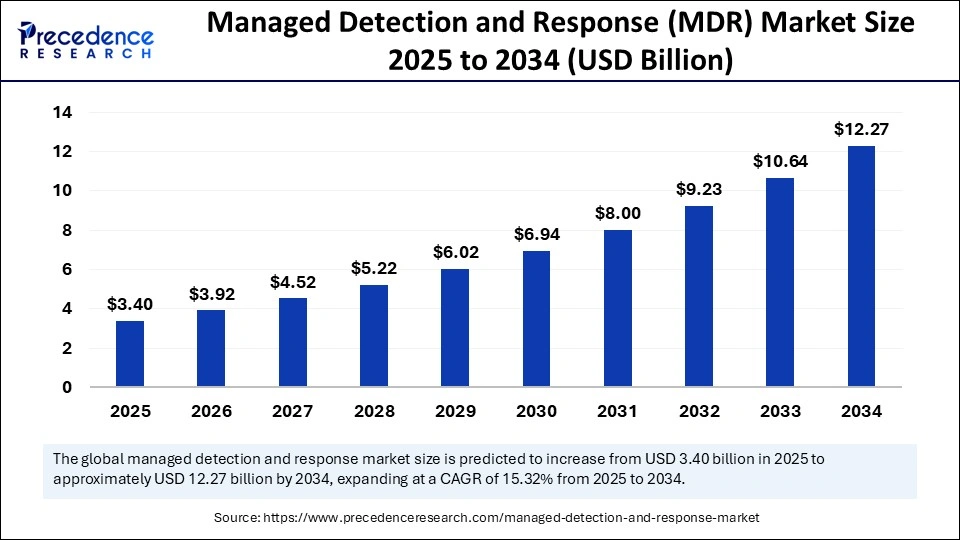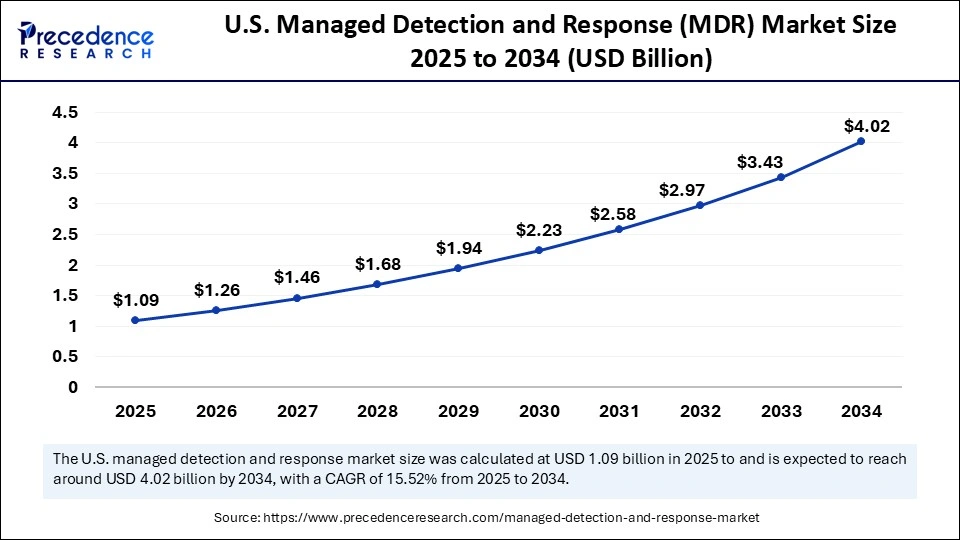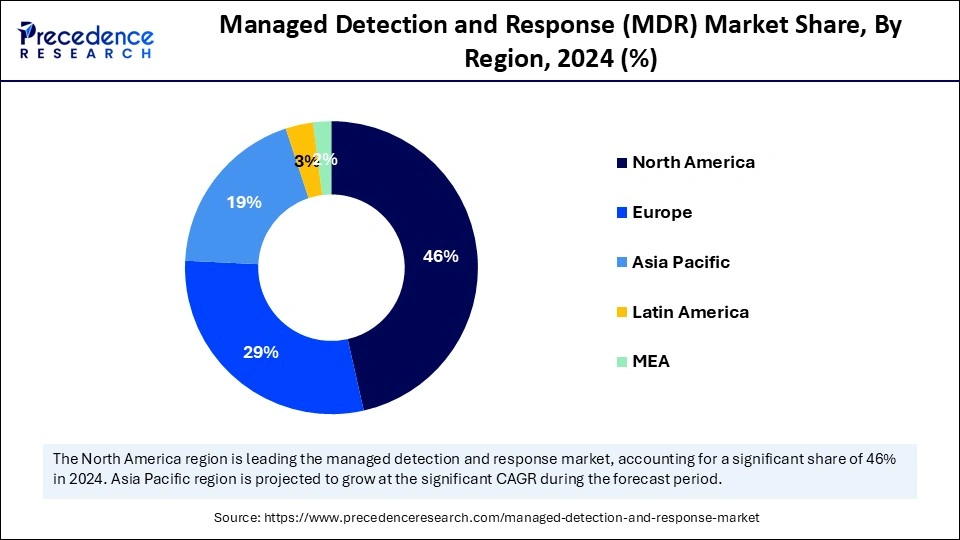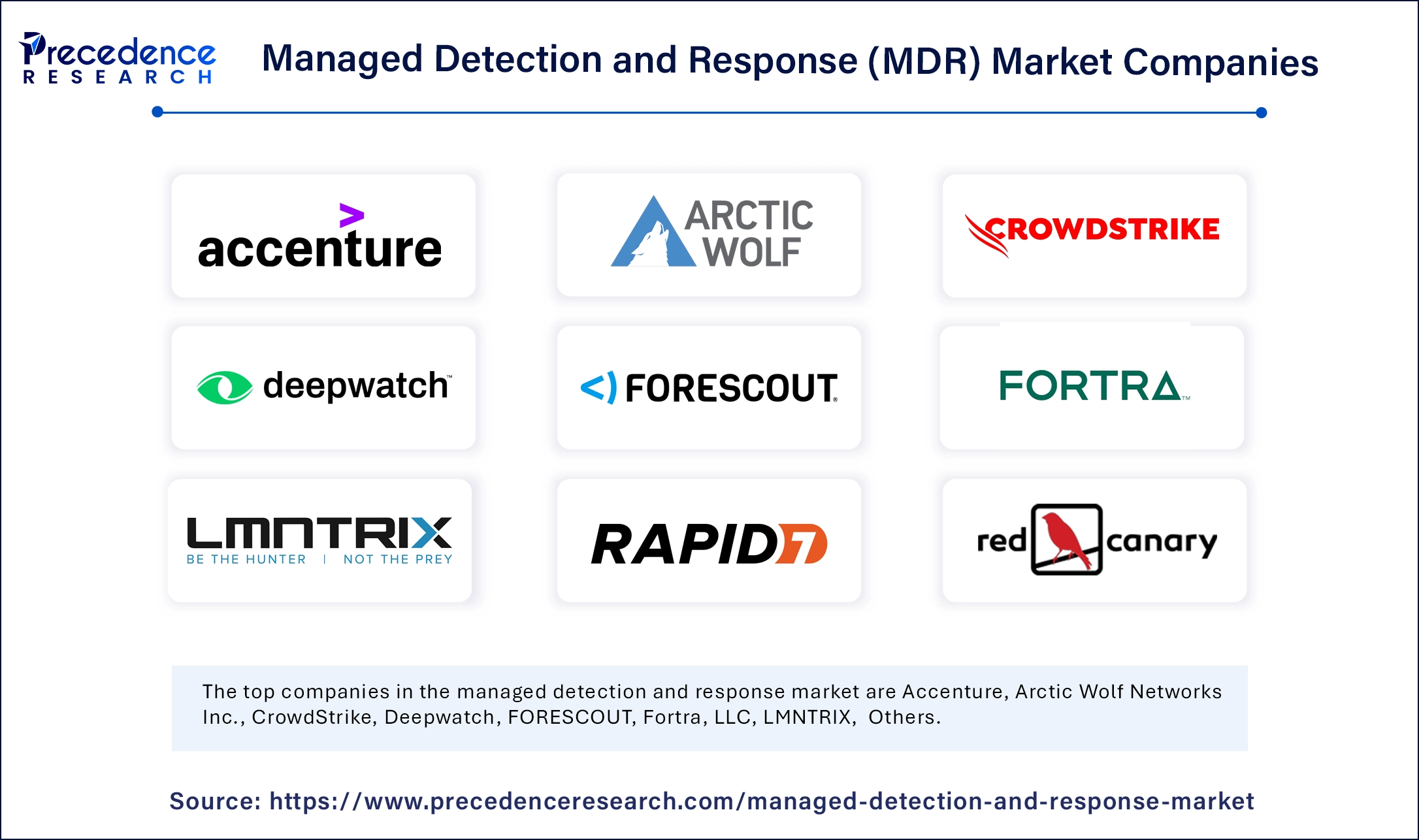June 2025
The global managed detection and response (MDR) market size accounted for USD 2.95 billion in 2024 and is predicted to increase from USD 3.4 billion in 2025 to approximately USD 12.27 billion by 2034, expanding at a CAGR of 15.32% from 2025 to 2034. The managed detection and response (MDR) market is growing due to the digital economy facing increasing compliance burdens because of overlying cybersecurity laws from different government bodies to address this growing need for managed detection and response solutions to protect individuals, organizations, and national interests by set morals for digital security.

Artificial Intelligence (AI) significantly impacts the managed detection and response (MDR) market. AI offers several advantages, including accelerating the identification and containment of cyberattacks. AI detects false positives, safeguarding security teams to emphasize genuine threats. AI-based insights enhance the accuracy of threat identification, lowering the challenges of oversight. The capability of AI to analyze massive datasets, predict emerging threats, and respond in real-time ensures that businesses remain resilient in the face of evolving risks. AI not only increases threat recognition but also enhances cybersecurity approaches. AI can analyze threat data from multiple sources and identify potential threats, enabling MDR providers to prepare for new attack vectors proactively.
The U.S. managed detection and response (MDR) market size was exhibited at USD 950 million in 2024 and is projected to be worth around USD 4.02 billion by 2034, growing at a CAGR of 15.52% from 2025 to 2034.

North America held the largest share of the managed detection and response (MDR) market in 2024. This is mainly due to its advanced digital infrastructure, increased adoption of novel technologies, and high government spending on connectivity initiatives and smart city projects. With the high adoption of cloud computing, the demand for MDR solutions has increased in the last few years. The region also faces a high volume of cyberattacks, boosting the demand for MDR solutions.
The U.S. is a major contributor to the market in North America. The increasing spending on robust cyber security solutions is a key factor boosting the growth of the market. The U.S. spends approximately USD 25 billion on cybersecurity solutions to defend federal systems against cyber threats like ransomware and hacking. The heightened awareness about cybersecurity risks, along with the high cybersecurity budgets of federal governments, banking, and manufacturing, further supports market growth. The country also boasts a robust IT infrastructure, boosting the need for managed detection and response solutions.

Asia Pacific is anticipated to witness the fastest growth during the forecast period. The managed detection and response (MDR) market in Asia Pacific can be attributed to the increasing popularity of automation and digital payments. Robust government frameworks regarding cyber security further support regional market growth. Governments around the region are progressively identifying cybersecurity status and imposing stringent regulations and laws to protect critical infrastructure. The rising integration of cutting-edge technologies in telecommunication and BFSI is further contributing to market growth in the region. With the rapid digital transformation in various industries, the frequency of cyberattacks is rising, boosting the need for MDR services.
Europe is projected to grow significantly during the forecast period. The growth of the market in Europe can be attributed to the rising awareness among businesses about cybersecurity risks. The increasing adoption of digital technologies and the growing penetration of the internet further support market growth. In addition, stringent regulations regarding data security and privacy are boosting the demand for robust security solutions like MDR, contributing to regional market growth.
The managed detection and response (MDR) market is growing rapidly due to the frequency and sophistication of cyberattacks. MDR services identify a broad range of threats, including suspicious activities in the network, access attempts, insider threats, unauthorized phishing attacks, and malware. Comprehensive MDR safety solutions encompass threat identification and an active response to lower the potential challenges. This proactive approach distinguishes MDR from conventional security solutions. With the increasing concerns of cyber threats, companies are focusing on actively addressing and remediating them.
MDR cybersecurity solutions are offered by EDR vendors and specialized managed security service providers (MSSPs). The rising demand for advanced approaches to security operations and threat management that are both proactive and reactive, like threat hunting, is boosting the market's growth. MDR solutions support organizations in managing threats and grappling with vulnerabilities.
| Report Coverage | Details |
| Market Size by 2034 | USD 12.27 Billion |
| Market Size in 2025 | USD 3.4 Billion |
| Market Size in 2024 | USD 2.95 Billion |
| Market Growth Rate from 2025 to 2034 | CAGR of 15.32% |
| Dominating Region | North America |
| Fastest Growing Region | Asia Pacific |
| Base Year | 2024 |
| Forecast Period | 2025 to 2034 |
| Segments Covered | Security Type, Deployment, Enterprise Size, Vertical, Region |
| Regions Covered | North America, Europe, Asia-Pacific, Latin America, and Middle East & Africa |
Rising Sophistication of Cyber Threats
The rising sophistication of cyber threats is a key factor driving the growth of the managed detection and response (MDR) market. With the increasing digitalization worldwide, challenges associated with addressing cyberattacks are rising. Cybercriminals are leveraging progressive technologies containing machine learning, bots, automation, and AI to intensify their attacks' complexity, speed, and scale, predominantly through ransomware, social engineering, and AI-based cybercrime. As a result, organizations face several challenges in adopting adaptive and proactive cybersecurity measures. This drives the demand for MDR solutions among businesses seeking continuous monitoring, quick incident response, and real-time threat identification to combat the evolving cyber threat landscape. MDR is progressively integrated into XDR (Extended Detection and Response) to provide an integrated and comprehensive technique of threat identification, adaptation, and response to novel threats.
Advanced Threat Evasion Techniques Pose Challenges
Despite the increasing demand for progressive cybersecurity solutions, the managed detection and response (MDR) market faces challenges because of the rising sophistication of cyberattacks targeting enterprises and SMBs. Threat actors are employing innovative tactics like fileless malware, polymorphic threats, and multi-stage attacks involving lateral movement methods that often evade detection, even by modern security monitoring devices such as SIEM and XDR. These advanced evasion techniques reduce the effectiveness of current MDR solutions, which limits the adoption of MDR solutions. Moreover, integrating MDR solutions into existing security systems can be challenging, restraining the growth of the market.
Evolving Threat Landscape
The increasing complexity of the cybersecurity landscape, driven by advanced tactics, techniques, and procedures (TTPs) used by cybercriminals, is creating significant opportunities in the managed detection and response (MDR) market. As traditional security measures prove inadequate against advanced and persistent threats, organizations are turning to MDR solutions for real-time threat identification, in-depth analysis, and quick incident response.
MDR providers offer a strategic combination of cutting-edge security technologies, cybersecurity analysis, and specialized monitoring devices that proactively safeguard network environments, critical infrastructure, and endpoints. This increasing demand for adaptive and proactive cybersecurity frameworks positions MDR services as a critical growth factor in the developing digital security ecosystem.
The cloud detection and response segment dominated the managed detection and response (MDR) market with the largest share in 2024. This is mainly due to the increased demand for robust security solutions. Cloud detection and response (CDR) enables organizations to prevent cyber threats in their cloud environments. CDR is a safety method for cloud environments that focuses on service incorporations, quick incident response, and threat identifications. It ensures comprehensive security that is tailored to cloud computing.
The managed endpoint detection and response (MEDR) segment is expected to expand at the fastest growth during the forecast period. This is mainly due to its capability to recognize and lower threats more efficiently than outdated safety solutions. MEDR solutions enable organizations to meet regulatory compliance by offering essential documentation and security controls.
The cloud-based segment held the largest share of the managed detection and response (MDR) market in 2024. This is primarily due to the heightened adoption of cloud-based models among banks, enterprises, and businesses. Cloud-based models, including hybrid, public, and private cloud, offer enhanced flexibility and scalability, making them suitable for large enterprises. These models are constructed based on various aspects. Cloud deployment is the method of deploying an application by one or more hosting models, like infrastructure as a service (IaaS), platform as a service (PaaS), and/or software as a service (SaaS).
The on-premises segment is likely to grow rapidly during the projection period. On-premises deployment provides several benefits, from improved safety to cost predictability. On-premises solutions provide businesses with full control over systems and data. These solutions offer customizable choices that cater to precise operational and regulatory requirements.
The SMEs segment led the managed detection and response (MDR) market with the largest share in 2024. This is mainly due to the rapid shift of SMEs toward cloud computing, making them susceptible to cyber threats. MDR solutions provide SMEs with improved visibility, quick incident response capabilities, and proactive threat identification, ultimately lowering the risk of cyberattacks and data breaches. MDR solutions offer continuous monitoring of whole IT environments, including cloud systems, endpoints, and networks.
The large enterprises segment is expected to expand at the highest CAGR during the forecast period. MDR solutions enable large enterprises respond quickly to cyberattacks and offers access to modern safety tools. Through the utilization of MDR, several large enterprises can lower the risk of data breaches and enhance their long-term safety. It emerged as an ideal solution for defensive organizations against sophisticated challenges. Moreover, large enterprises often deal with vast data, making them vulnerable to cyber threats. This, in turn, boosts the demand for MDR solutions.
The BFSI segment led the managed detection and response (MDR) market in 2024. As BFSI organizations handle vast sensitive data, they often require robust security solutions. MDR solutions enable them to quickly identify threats and minimize the impact of threats. They continuously monitor network anomalies, quickly responding to cyber threats.
The IT & telecom segment is likely to witness the fastest growth in the upcoming period. IT and telecom businesses heavily depend on robust security solutions as they handle a large amount of data, making them susceptible to cyberattacks. The rapid expansion of the IT infrastructure and shift toward cloud computing are likely to boost the growth of the segment.

By Security Type
By Deployment
By Enterprise Size
By Vertical
By Region
For inquiries regarding discounts, bulk purchases, or customization requests, please contact us at sales@precedenceresearch.com
No cookie-cutter, only authentic analysis – take the 1st step to become a Precedence Research client
June 2025
August 2025
July 2025
July 2025